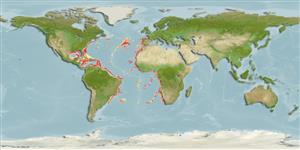Environment: milieu / climate zone / depth range / distribution range
Ecology
Marine; bathypelagic; depth range 500 - 2000 m (Ref. 4460). Deep-water; 45°N - 34°S, 98°W - 17°E
Eastern Atlantic: southern Bay of Biscay to Namibia. Western Atlantic: Gulf of Mexico, Caribbean, and off Brazil.
Size / Weight / Age
Maturity: Lm ? range ? - ? cm
Max length : 24.0 cm SL male/unsexed; (Ref. 4460)
Benthic on soft bottoms (Ref. 51024).
Life cycle and mating behavior
Maturities | Reproduction | Spawnings | Egg(s) | Fecundities | Larvae
Markle, D.F. and J.-C. Quéro, 1984. Alepocephalidae (including Bathylaconidae, Bathyprionidae). p. 228-253. In P.J.P. Whitehead, M.-L. Bauchot, J.-C. Hureau, J. Nielsen and E. Tortonese (eds.) Fishes of the North-eastern Atlantic and the Mediterranean. UNESCO, Paris. Vol. 1. (Ref. 4736)
IUCN Red List Status (Ref. 130435)
Threat to humans
Harmless
Human uses
Tools
Special reports
Download XML
Internet sources
Estimates based on models
Preferred temperature (Ref.
123201): 3.9 - 9.9, mean 5.6 °C (based on 277 cells).
Phylogenetic diversity index (Ref.
82804): PD
50 = 0.5312 [Uniqueness, from 0.5 = low to 2.0 = high].
Bayesian length-weight: a=0.00347 (0.00164 - 0.00733), b=3.19 (3.00 - 3.38), in cm total length, based on LWR estimates for this (Sub)family-body shape (Ref.
93245).
Trophic level (Ref.
69278): 3.5 ±0.5 se; based on size and trophs of closest relatives
Resilience (Ref.
120179): Medium, minimum population doubling time 1.4 - 4.4 years (Preliminary K or Fecundity.).
Fishing Vulnerability (Ref.
59153): Low vulnerability (19 of 100).
